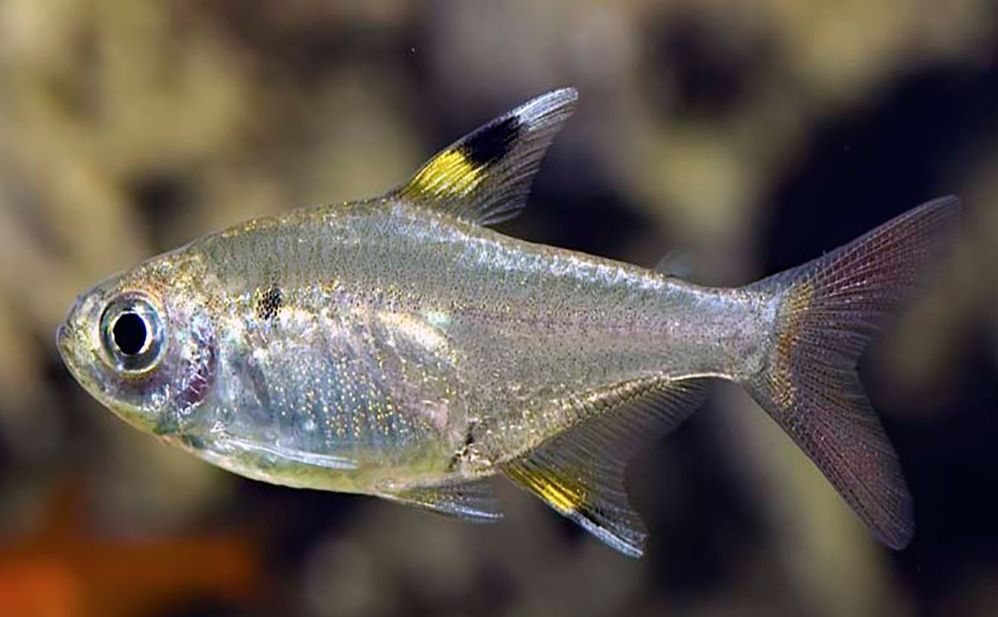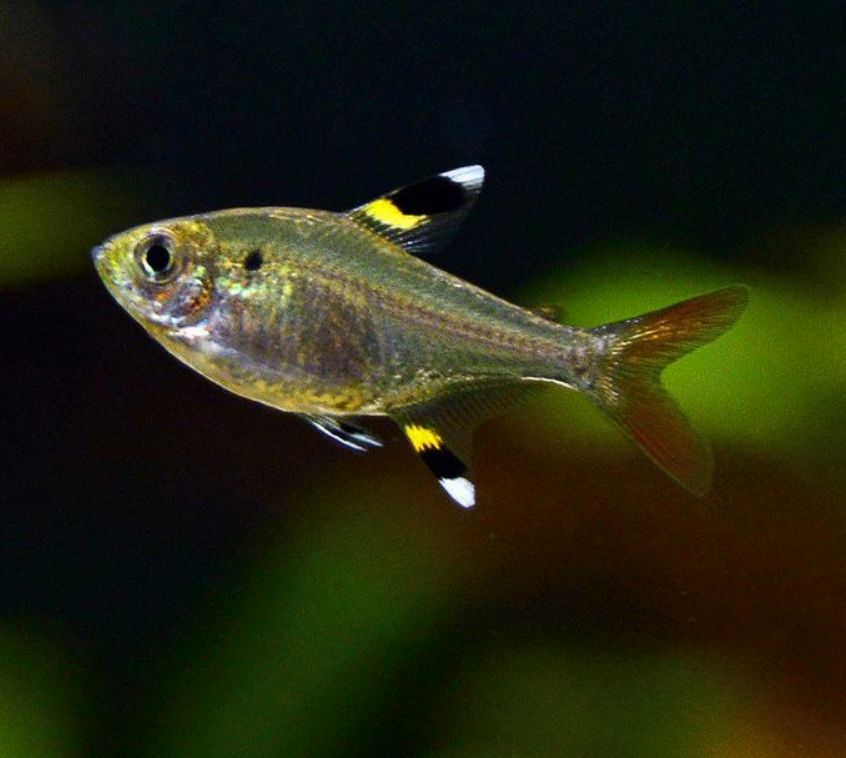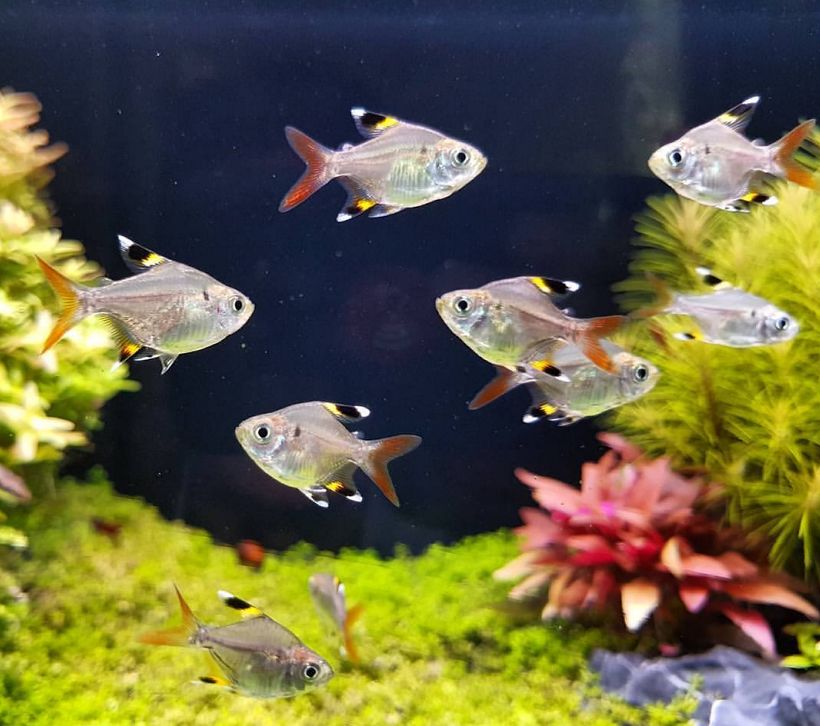X-ray fish, a member of the Characidae family, is the sole species of the Pristella genus. Known for its unique translucent body, this fish is an ideal choice for beginner aquarists due to its hardiness and adaptability. X-ray fish thrive in a variety of water conditions, making them easy to care for. They can live comfortably in both soft and hard water, and their peaceful nature allows them to coexist with other community fish. Their striking appearance and undemanding requirements make them a delightful addition to any aquarium.

Contents
Habitat in the wild
Pristella maxillaris, commonly known as the x-ray tetra or x-ray fish, belongs to the Characidae family—a large and diverse group of freshwater fish. This family includes many popular aquarium species, such as tetras, hatchetfish, and pencilfish, making it a favorite among fish enthusiasts.
X-ray tetras are native to South America, primarily found in the Amazon and Orinoco river basins, as well as the rivers of Guyana. They inhabit slow-moving or still waters, particularly in regions with dense vegetation, such as flooded forests, tributaries, and inundated meadows during the wet season. These fish thrive in water bodies that have soft, acidic conditions and can often be found in brackish waters near shorelines.
During the rainy season, x-ray tetras migrate to flooded areas of the fluvial plains, including savannas and forest canopies, to spawn. In their natural environment, they prefer the middle to upper levels of the water column, swimming among plants and seeking shelter in submerged vegetation. This species is well-adapted to a tropical climate, thriving in warm water temperatures.

Description
Size
The x-ray tetra typically reaches a length of about 2 inches (5 cm) when fully mature. This compact size makes them ideal for community tanks, where their striking translucent bodies add visual interest. Their small stature allows them to coexist comfortably with various other species, enhancing the diversity of any aquarium setup.
Lifespan
In a well-maintained aquarium with optimal conditions, x-ray tetras generally live for about 3 to 5 years. Factors such as water quality, diet, genetics, and overall care can influence their lifespan, with some individuals potentially living slightly longer or shorter depending on their specific environment and care practices.
Body Characteristics
The body of the x-ray tetra is semitransparent, allowing a view of its skeleton and internal organs, which contributes to its name. Their bodies are moderately long and laterally flattened, featuring a high back and a characteristic fatty fin. The coloration of their translucent body ranges from olive to olive green, often with a silvery tint. Notably, they have a black spot near the forebody, and this pattern extends to their lemon-yellow dorsal, anal, and abdominal fins, which also have white edges.
Additionally, there are albino variants of x-ray tetras, characterized by red eyes and a paler body coloration, though these are less commonly available in the aquarium trade.
| Characteristic | Description |
|---|---|
| Scientific Name | Pristella maxillaris |
| Common Name | X-ray Tetra, pristella tetra |
| Family | Characidae |
| Origin | Amazon River Basin (South America) |
| Size | About 2 inches (5 cm) |
| Lifespan | 3 to 5 years (in proper care) |
| Aquarium Size | 15 gallons or larger for a small group |
| Temperature Range | 75°F to 82°F (24°C to 28°C) |
| pH Range | 6.0 to 7.5 |
| Hardness | Soft to slightly hard (2-15 dGH) |
| Behavior | Peaceful, schooling |
| Diet | Omnivorous, accepts flake and live foods |
| Tank Decor | Plants, driftwood, hiding spots |
| Water Flow | Gentle to moderate |
| Breeding Difficulty | Moderate (requires separate breeding tank) |
Difficulties in keeping
X-ray fish is easy both to keep and to breed. It is peaceful and suitable for any company of small fishes as well as it is rather enduring. The fish is undemanding in terms of food and it wasn’t observed when eating tank plants.
Care and keeping in a tank
Tank Size
The recommended tank size for x-ray tetras depends on the number of fish and the aquarium’s overall setup. Since these fish reach about 2 inches (5 cm) in length and are peaceful schooling fish, it’s best to keep them in groups. A general guideline is to provide at least a 15-gallon (56.8 liters) tank for a small group of x-ray tetras. However, larger tanks offer more swimming space, better water stability, and allow for larger schools, which can enhance their social behavior.
Considerations for Tank Size
- Stocking Density: For optimal social interaction, aim for a school of at least six tetras. A 20-gallon tank is recommended for 10-12 fish to prevent overcrowding.
- Aquarium Shape: Longer tanks provide more horizontal swimming space, which is beneficial for schooling fish like x-ray tetras.
Water Parameters
X-ray tetras are hardy fish that can adapt to various water parameters, though specific conditions are ideal for their health. Here are the recommended tank water parameters:
Temperature
X-ray tetras thrive in tropical temperatures between 75°F and 82°F (24°C to 28°C). Maintaining a stable temperature within this range is essential to prevent stress.
pH Level
Aim for a slightly acidic to neutral pH level, ideally between 6.0 and 7.5. Avoiding extreme pH swings is crucial for their well-being.
Water Hardness
Coming from the soft waters of the Amazon River Basin, x-ray tetras prefer low to moderate hardness, ideally between 2 and 15 dGH (German degrees of hardness). While soft water is preferable, they can tolerate slightly harder conditions.
Ammonia and Nitrite
Both substances should be kept at zero to prevent toxicity. Regular water changes, effective filtration, and avoiding overfeeding are key to maintaining low levels.
Nitrate
Although less toxic than ammonia and nitrite, nitrate should remain below 40 ppm (parts per million), with lower levels being preferable.
Water Movement
A gentle to moderate water flow is sufficient for x-ray tetras, as they do not require strong currents. Providing calmer areas allows the fish to rest comfortably.
Tank Decor
Incorporating live or artificial plants not only stabilizes water parameters, particularly pH, but also provides hiding spots, enhancing the fish’s comfort.
Plant Options
- Live Plants: Consider species like java fern or anubias, which can thrive in low-light conditions and help with water quality.
- Hiding Spots: Use driftwood or caves to create hiding places, reducing stress for the fish.
Maintenance Tips
Regular monitoring of water parameters is vital, especially when establishing a new aquarium or introducing new fish. Routine maintenance, including bottom substrate cleaning and weekly water changes of 15–20%, will help ensure the health and longevity of your x-ray tetras.

Diet
X-ray tetras are omnivorous fish that thrive on a varied diet, mirroring their natural feeding habits in the wild. In their native habitat, they consume small aquatic insects, zooplankton, and plant matter. To maintain their health and vitality in captivity, it is essential to provide a well-rounded diet that meets their nutritional needs.
A good quality tropical fish flake food serves as the staple diet for x-ray tetras. Select a brand that offers a balanced mix of ingredients, including proteins, vitamins, and minerals, to ensure they receive essential nutrients. This base diet is crucial for their overall health and development.
To enhance their diet, consider offering occasional servings of live or frozen foods such as daphnia, brine shrimp, bloodworms, and small aquatic invertebrates. These protein-rich options are important for their growth, particularly for young or actively breeding fish. Live foods can also stimulate natural hunting instincts, making feeding time more engaging and enjoyable for the fish.
When feeding x-ray tetras, practice portion control by offering small amounts multiple times a day instead of a large quantity at once. This approach mimics their natural feeding behavior and helps prevent overeating, which can lead to poor water quality and health issues. It’s crucial to ensure that all food offered is appropriately sized for their small mouths. Crushed flakes and small pellets are ideal, allowing them to eat comfortably without difficulty.
Providing a diverse and balanced diet is key to keeping x-ray tetras active and vibrant. Regularly rotating their food choices will not only enhance their health but also encourage natural behaviors, contributing to a thriving aquarium environment. Additionally, monitor their response to different foods; some individuals may have preferences or dietary sensitivities. Ensuring they receive a varied diet can enhance their coloration and overall appearance, making them even more visually appealing in your aquarium.
Remember to avoid overfeeding, as this is a common mistake among aquarists. Maintaining a consistent feeding schedule can help preserve water quality and support the health of your x-ray tetras, allowing them to flourish in their aquatic home.
Tank mates
X-ray tetras are generally peaceful and social fish, making them excellent candidates for community aquariums. When selecting tank mates for x-ray tetras, it’s crucial to choose species that have similar water parameters and temperaments to ensure a harmonious environment. Suitable companions include other small, non-aggressive fish such as neon tetras, rasboras, and guppies, which can coexist peacefully without stressing each other.
Always monitor the tank for signs of aggression or stress, as some fish may display territorial behaviors. It’s important to avoid pairing x-ray tetras with overly aggressive species or known fin nippers, as this can lead to injuries and a disruptive environment. Additionally, a well-planted aquarium with plenty of hiding spots and open swimming areas can significantly reduce stress for x-ray tetras and their tank mates.
Here are some compatible tank mates:
- Other Small Tetras: Since X-ray tetras are tetras themselves, they generally get along well with other small tetra species. Examples include Neon Tetras, Cardinal Tetras, Rummy Nose Tetras, and Glowlight Tetras. These species are of similar size and share similar water requirements.
- Corydoras Catfish: Corydoras catfish are peaceful bottom-dwelling fish that can make great tank mates for X-ray tetras. They help keep the substrate clean and are generally compatible in terms of temperament and water preferences.
- Small Rasboras: Many rasbora species, such as Harlequin Rasboras, are suitable companions for X-ray tetras. They are peaceful, colorful, and occupy different levels in the tank.
- Dwarf Gouramis: Certain species of dwarf gouramis, like the Honey Gourami or Sparkling Gourami, can work well as tank mates, especially in larger aquariums with ample hiding spots. Make sure the tank is adequately sized to prevent territorial issues.
- Small Livebearers: Some small livebearers, such as Endler’s Livebearers, can be compatible with X-ray tetras. However, avoid larger or more aggressive livebearers, as they may stress out the tetras.
- Peaceful Bottom Dwellers: Species like Otocinclus catfish (for algae control), small shrimp (e.g., cherry shrimp), or peaceful snails can coexist with X-ray Tetras, adding diversity to the tank.
Gender differences: male vs female
Determining the sex of x-ray tetras can be challenging, especially in juvenile fish. However, some subtle differences become more noticeable as the fish mature. Generally, females may be slightly larger and rounder than males, particularly when they are carrying eggs. This difference in body size can help in identifying females, especially during breeding conditions.
There may also be slight variations in the dorsal fins. Males often have more elongated or pointed dorsal fins, but this distinction can be subtle and may not be obvious in all individuals. The coloration of mature females may appear more rounded and fuller in the belly area, particularly when they are ready to spawn, although coloration can vary among fish and may not always be a reliable indicator.
When females are prepared to spawn, their abdomens may exhibit a noticeable bulge, indicating the presence of eggs. This sign is most apparent when the fish are well-fed and approaching the breeding season. During this time, males may display more intense coloration and engage in courtship behaviors, such as chasing and displaying their fins, to attract females.
Observing these behaviors, particularly in a breeding setup, can provide clues for differentiation.asier to differentiate between sexes when the fish are in a breeding condition or when you have a group of mature fish to observe. If you’re interested in breeding X-ray tetras, it’s best to observe their behavior and monitor any signs of spawning activity.
Breeding
If you are interested in breeding x-ray tetras, keep in mind that environmental changes can trigger spawning. Optimal conditions include water with average hardness and a neutral pH, with temperatures maintained between 25 and 26 °C. A smaller spawning tank of around 5-6 liters is ideal for the breeding pair. After introducing the pair to the spawning tank, they may begin to spawn the following morning. If spawning does not occur, it is advisable to keep the fish in the tank for an additional day or two, and offering a small amount of food, such as 3-4 bloodworms or coretra per fish, can stimulate activity.
The eggs laid by the pair are small, transparent, and non-sticky. After spawning, it’s essential to remove the breeders back to the community tank and leave the eggs undisturbed for about 5-6 days until they hatch. Once the juveniles emerge, they require a standard feeding regimen. On the sixth day post-hatching, provide their first food, which should consist of small pond microorganisms like daphnia or cyclop nauplii during warmer months. In winter, prepare infusorians in advance to ensure a continuous food supply.
After a week, the juveniles can be fed larger live food, such as brine shrimp nauplii, cyclops, and daphnia. They can also consume vinegar eels, which are beneficial for their growth. As they develop, gradually increase the size of their food. It’s worth noting that juveniles grow relatively slowly; at six months old, they typically reach lengths of 2.5 to 3 cm and become reproductive. This gradual growth requires patience and consistent care to ensure their healthy development.